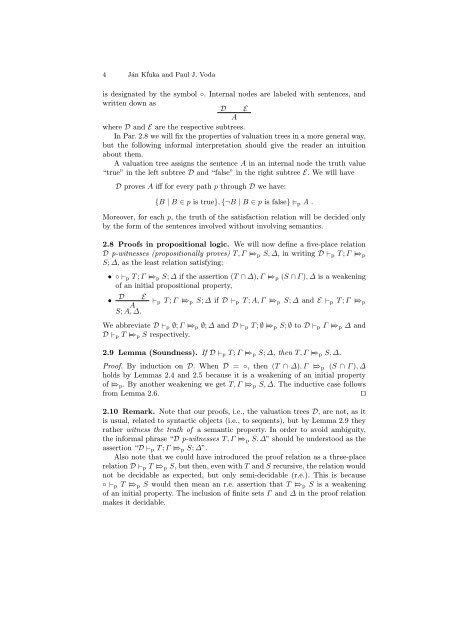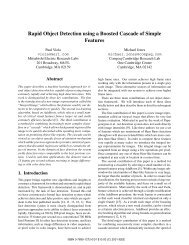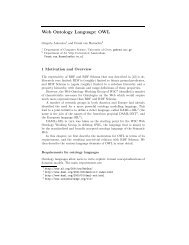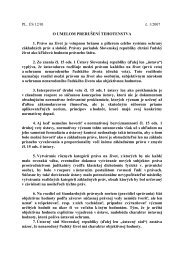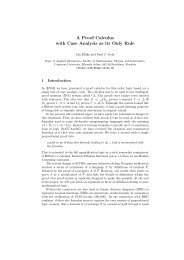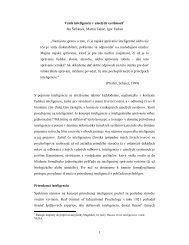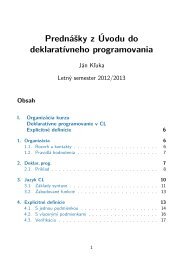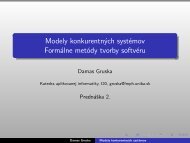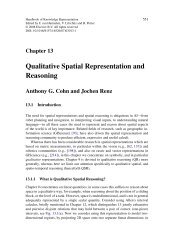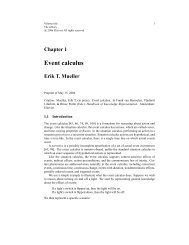A Simple and Practical Valuation Tree Calculus for First-Order Logic
A Simple and Practical Valuation Tree Calculus for First-Order Logic
A Simple and Practical Valuation Tree Calculus for First-Order Logic
You also want an ePaper? Increase the reach of your titles
YUMPU automatically turns print PDFs into web optimized ePapers that Google loves.
4 Ján Kľuka <strong>and</strong> Paul J. Vodais designated by the symbol ◦. Internal nodes are labeled with sentences, <strong>and</strong>written down asD EAwhere D <strong>and</strong> E are the respective subtrees.In Par. 2.8 we will fix the properties of valuation trees in a more general way,but the following in<strong>for</strong>mal interpretation should give the reader an intuitionabout them.A valuation tree assigns the sentence A in an internal node the truth value“true” in the left subtree D <strong>and</strong> “false” in the right subtree E. We will haveD proves A iff <strong>for</strong> every path p through D we have:{B | B ∈ p is true}, {¬B | B ∈ p is false} p A .Moreover, <strong>for</strong> each p, the truth of the satisfaction relation will be decided onlyby the <strong>for</strong>m of the sentences involved without involving semantics.2.8 Proofs in propositional logic. We will now define a five-place relationD p-witnesses (propositionally proves) T, Γ ⇒ p S, ∆, in writing D ⊢p T ; Γ ⇒ pS; ∆, as the least relation satisfying:• ◦ ⊢p T ; Γ ⇒ p S; ∆ if the assertion (T ∩ ∆), Γ ⇒ p (S ∩ Γ ), ∆ is a weakeningof an initial propositional property,• D EAS; A, ∆.⊢p T ; Γ ⇒ p S; ∆ if D ⊢p T ; A, Γ ⇒ p S; ∆ <strong>and</strong> E ⊢p T ; Γ ⇒ pWe abbreviate D ⊢p ∅; Γ ⇒ p ∅; ∆ <strong>and</strong> D ⊢p T ; ∅ ⇒ p S; ∅ to D ⊢p Γ ⇒ p ∆ <strong>and</strong>D ⊢p T ⇒ p S respectively.2.9 Lemma (Soundness). If D ⊢p T ; Γ ⇒ p S; ∆, then T, Γ ⇒ p S, ∆.Proof. By induction on D. When D = ◦, then (T ∩ ∆), Γ ⇒ p (S ∩ Γ ), ∆holds by Lemmas 2.4 <strong>and</strong> 2.5 because it is a weakening of an initial propertyof ⇒ p . By another weakening we get T, Γ ⇒ p S, ∆. The inductive case followsfrom Lemma 2.6.⊓⊔2.10 Remark. Note that our proofs, i.e., the valuation trees D, are not, as itis usual, related to syntactic objects (i.e., to sequents), but by Lemma 2.9 theyrather witness the truth of a semantic property. In order to avoid ambiguity,the in<strong>for</strong>mal phrase “D p-witnesses T, Γ ⇒ p S, ∆” should be understood as theassertion “D ⊢p T ; Γ ⇒ p S; ∆”.Also note that we could have introduced the proof relation as a three-placerelation D ⊢p T ⇒ p S, but then, even with T <strong>and</strong> S recursive, the relation wouldnot be decidable as expected, but only semi-decidable (r.e.). This is because◦ ⊢p T ⇒ p S would then mean an r.e. assertion that T ⇒ p S is a weakeningof an initial property. The inclusion of finite sets Γ <strong>and</strong> ∆ in the proof relationmakes it decidable.


